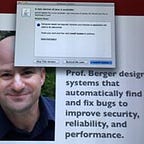A Guide for Session Chairs
3 min readJun 8, 2016
I just sent this message as a guide to the program committee members who will be chairing sessions for PLDI 2016 (I figure it’s the first time for some of them). A few people suggested I post it, so here it is (lightly edited, cross-posted from my blog). Additions or other suggestions welcome.
- Find your speakers before the session begins. You will have to talk to them about some stuff — see below.
- Find out how to pronounce their names properly.
- Find out if they are on the market next year — sometimes people like the advertisement that they will be graduating soon.
- Have them check their equipment (particularly if they are using Linux…).
- Before each session, introduce the entire session (as in, “I am So-and-So, from Wherever University; welcome to the session on drone-based programming languages.”
- Before each talk, introduce each speaker. I personally recommend not reading their title, since lots of speakers are on autopilot and will just repeat everything you said. You can instead say something like “This is Foo Bar, who will be talking about verifying clown car drivers.” In fact, come to think of it, you could just say that for every talk.
- Keep track of time. For PLDI this year, speakers get 25 minutes, and then there are 5 minutes for questions. If you have an iPad, there’s an app I have used to display time to speakers (big giant numbers, you can set it to change colors when you hit 5 min or 1 min till the end). You can of course always go old school and hold up a sheet of paper indicating when time is drawing near. I recommend doing this when there are 5 minutes left and 1 minute left. Let the speakers know you will be doing this.
- When the speaker is done, if it hasn’t happened already, make sure everyone applauds by saying “Let’s thank our speaker” and start applauding. Then open the floor to questions.
- COME PREPARED WITH A QUESTION. The worst thing ever is when the talk is a disaster does not go well and no one has any questions for the speaker, and then: <crickets>. Read over each paper so you have at least a couple of questions planned. Hopefully it won’t come to this, but it happens sometimes, and it’s great if you can save the day.
- Make sure people who ask questions use the mic and state their name and affiliation.
- You may also have to clarify the question for the speaker, repeat the question, etc. Understanding questioners can occasionally be a challenge for non-native English speakers: it’s a stressful time, and the questioners may have unfamiliar accents, etc. Be prepared to give the speaker a helping hand.
- Be prepared to cut off a questioner. YOU ARE IN CHARGE OF THE SESSION. If a questioner won’t give up the mic and keeps asking questions and is burning time, rambling, etc., you are empowered to move on to the next questioner (e.g., by suggesting “how about we take this off-line”).
- Hopefully this won’t be an issue you will have to deal with, but questioners who are belligerent or insulting must not be tolerated. Cut them off and report them to the program chair (me) or the general chair. I sincerely hope and expect that this will not happen, but I want you to realize you are empowered to take action immediately. You can read over SIGPLAN’s non-harassment policy here, which is based on ACM’s: http://www.sigplan.org/Resources/Policies/CodeOfConduct/.
- To make sure things run smoothly, have the next speaker on deck with their laptop a minute or so before question times end. Ideally, they will be setting up while the current speaker is wrapping up questions.
- Finally, when questions are over, say “Let’s thank our speaker again” and applaud.
And thanks again to all the session chairs for volunteering!
